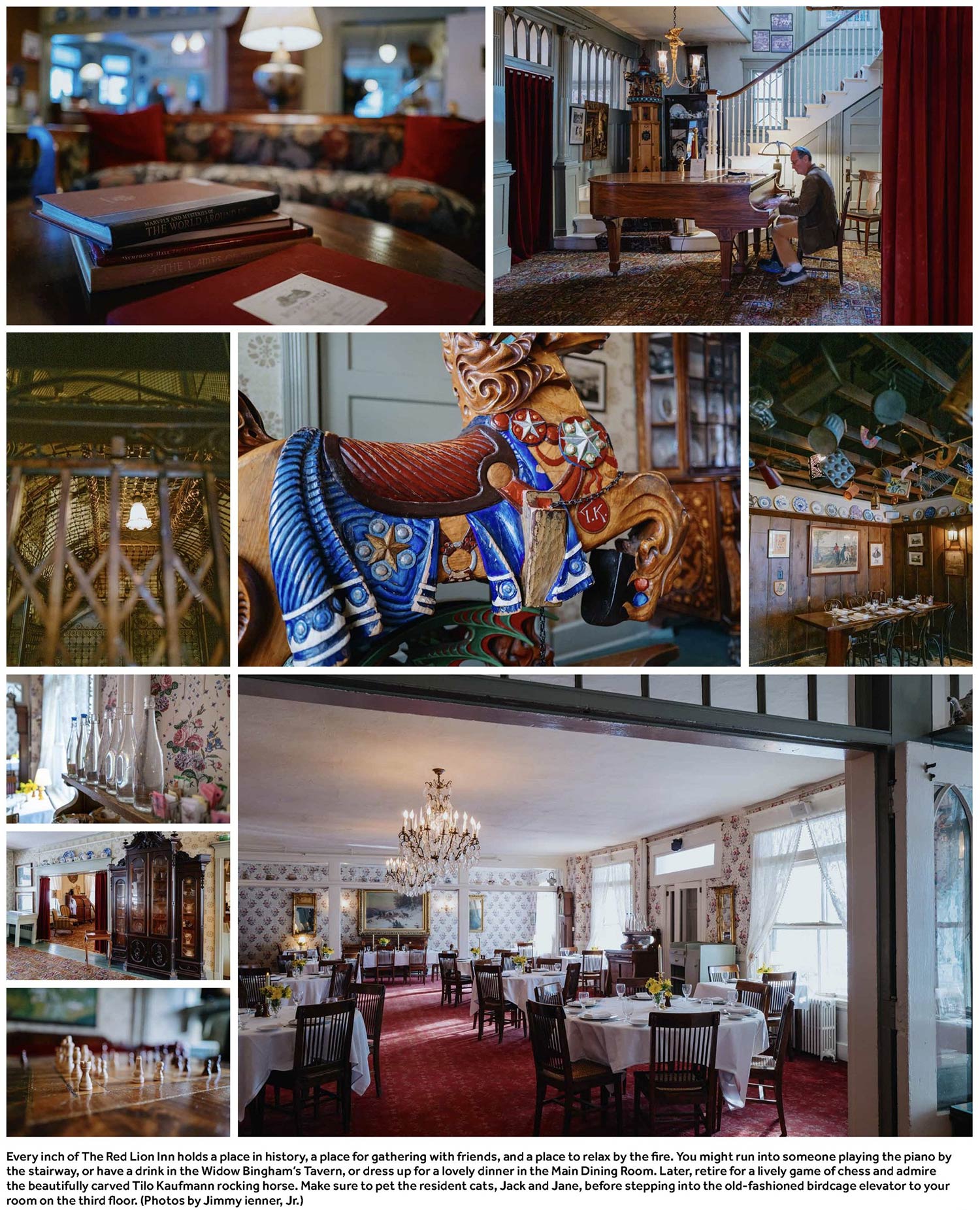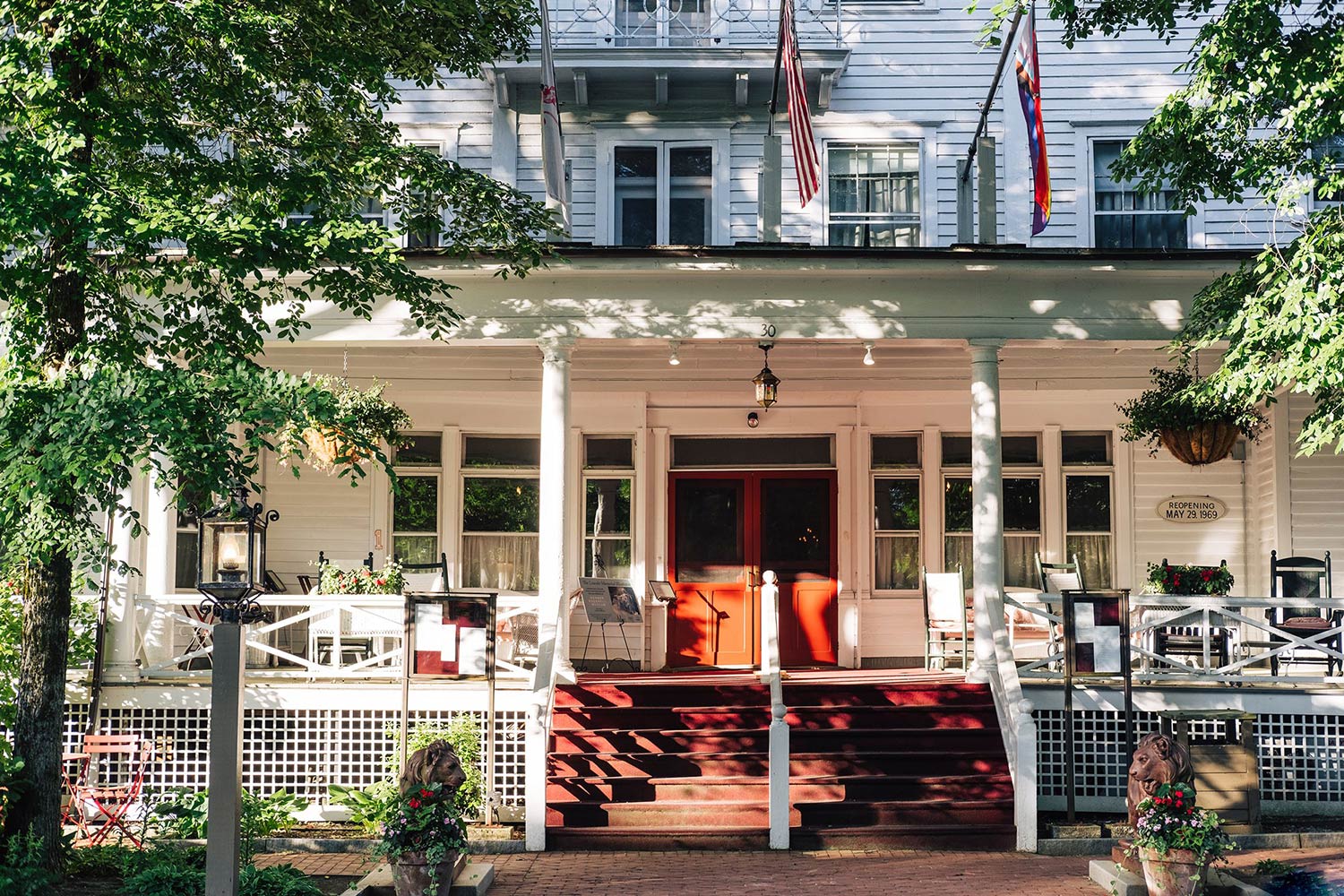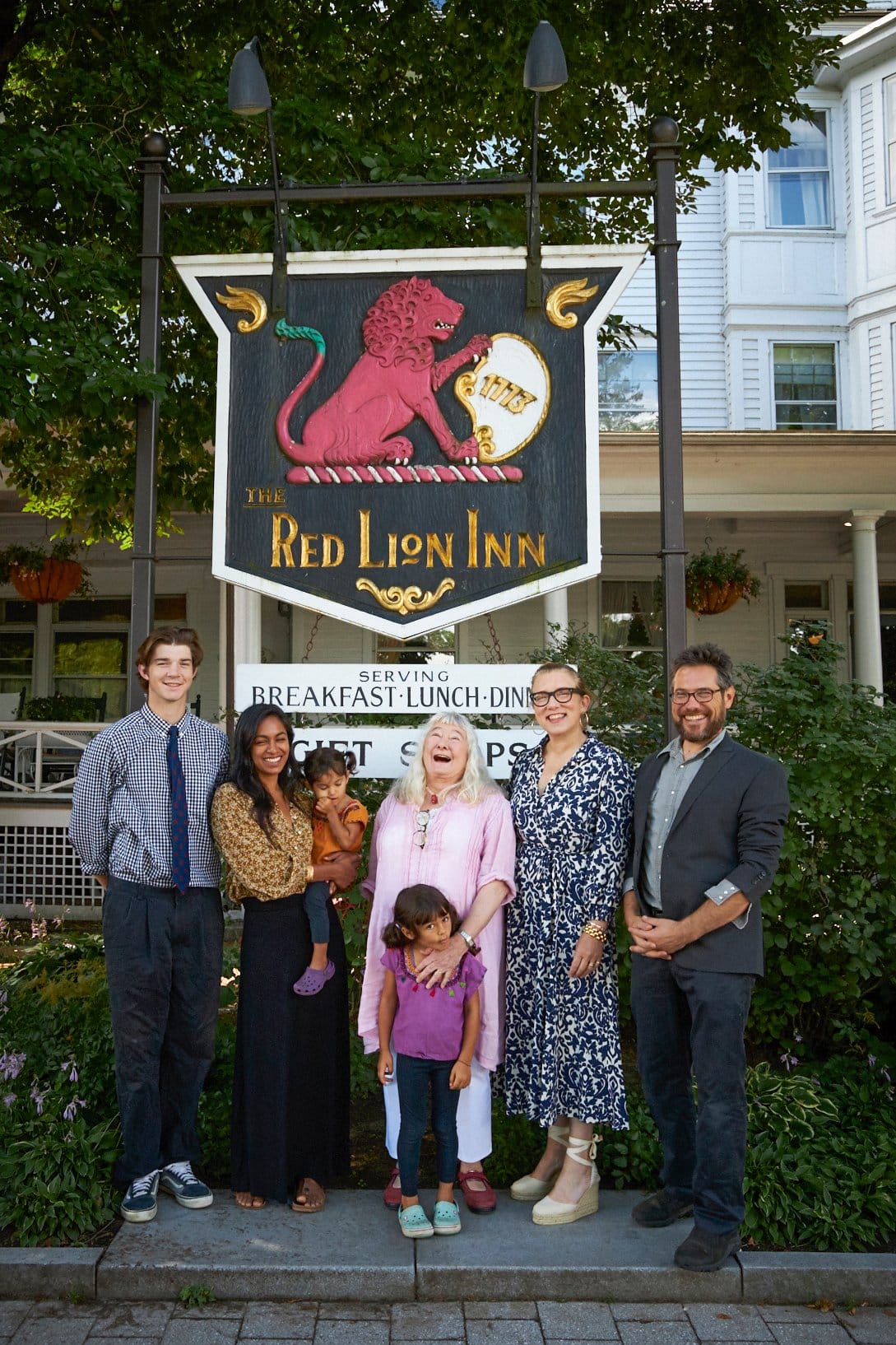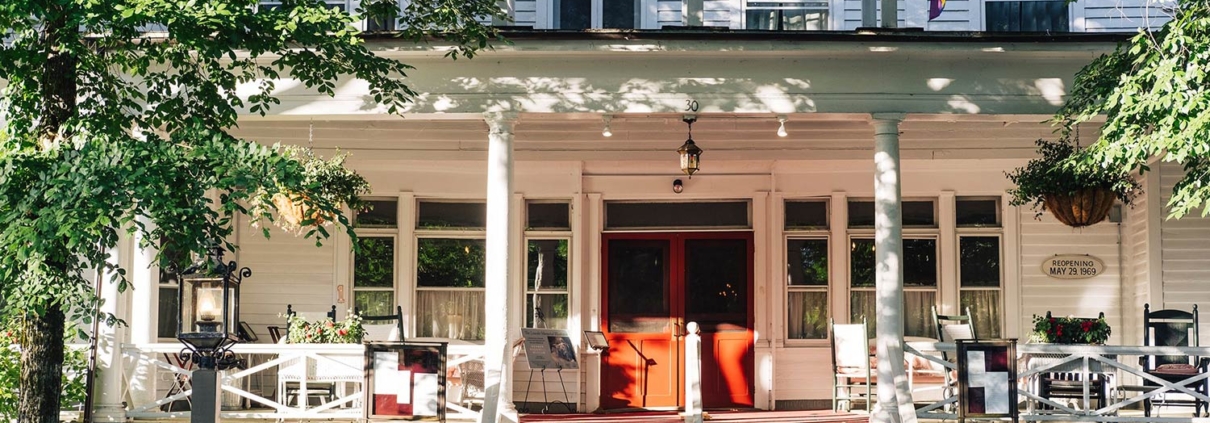A ROARING 250 Years
This article was originally published in Berkshire Magazine in the Spring 2023 issue, celebrating the 250th anniversary of Red Lion Inn. Step into the enchanting world of a historic Berkshires establishment visited by illustrious guests from FDR to Norman Rockwell.
THE RED LION INN CELEBRATES A QUARTER MILLENNIUM
By Anastasia Stanmeyer
Each interview for this story occurred in a noteworthy pace at The Red Lion Inn. Come to think of it, every inch of the inn is noteworthy; as a story to tell.
I sat at the desk of inn historian Anne Oppermann, on the third floor where Country Curtains once was located and where Main Street Hospitality Group now is headquartered.
The next morning in the Main Dining Room, I met with Carla Child, director of project management for Main Street Hospitality. The area was gently lit by the pale afternoon light coming in from a nearby window; a small vase with fresh flowers sat between us on a crisp, white tablecloth. Within arm’s reach was “The Rockwell Table”—a large dining table famously portrayed in the painter’s Freedom From Want.

A few days earlier, Sarah Eustis led me to a cozy corner that was home to an impressive wooden horse carved by one of the founders of the Steiner School in Great Barrington.
“When I first came on 11 years ago, fresh from Paris, I was trying to find my place here. Why are we doing this? Why don’t we change that? It’s old and stuffy,” says Sarah, who owns The Red Lion Inn with her siblings and is CEO of Main Street Hospitality, which manages and operates the inn and other properties spread across the Northeast and Canada. “Since then, I’ve realized that this chess table where we’re sitting at, the Tilo Kaufmann rocking horse, the Seiji Ozawa prints on the wall, they have been in these positions for a long time. In fact, remaining in these positions provides reassurance for people when they come in. It doesn’t mean that they will never change. But if they did, it’s a big deal. It has to be a discussion.”
To say that history is alive and well at The Red Lion Inn sounds cliché. But it’s true. The past mingles with the present. Time is suspended. If you pause long enough and rest your gaze on a piece of furniture, a painting on the wall, a teapot on a shelf, you become curious as to why it’s there. The Red Lion Inn is as authentic as when it began in 1773.


Let’s go back as we look to the future and explore the people and the artifacts that make The Red Lion Inn arguably the most well-known property in the Berkshires. Let’s go back to Anne at her desk in an expansive office area on the third floor. She is the keeper of the inn’s history—Country Curtains catalogues, The Red Lion Inn scrapbooks, Fitzpatrick family photos, obituary listings, architectural drawings, and so on. She knows where all this material is located—in the historical room at The Stockbridge Library, in the inn’s office storage area, in a closet on the inn’s fourth floor, on her desk.
Take the old register books, which contain signatures of historically famous names such as Ethan Allen, Sinclair Lewis, Frank Crowninshield, Eleanor Roosevelt, Edna Ferber, Julian Bond, Edward Everett Horton, Fritz Kreisler, Buster Keaton, Henry W. Longfellow, Oscar of the Waldorf, Nathaniel Hawthorne, William Cullen Bryant, Herman Melville, and others.
In 1935, Heaton Treadway, the owner at the time, had a bright idea of establishing a special guestbook that would be placed in the rooms of famous guests to sign. Tracy Coolidge, the wife of President Coolidge, was the first. Along with her husband, Calvin, five other presidents have visited the inn: Grover Cleveland, William McKinley, Theodore Roosevelt, William Howard Taft, and Franklin Delano Roosevelt. (One story is that when FDR was a student at Harvard, he spent a weekend visiting a young lady in Lenox. They drove to The Red Lion Inn for supper and were in no hurry to return to Lenox. At 11 p.m., the young lady’s mother became so worried that she sent out a search party for the young ones.)
The Berkshire Theatre Festival drew stars to the area who made their temporary home at The Red Lion Inn, including Paul Newman and Joanne Woodward, Daniel J. Travanti, Julie Harris, and Teresa Wright. With Tanglewood nearby, con- ductors and artists like Leonard Bernstein, John Williams, Itzhak Perlman, and James Taylor also stayed there. Playwright Thornton Wilder returned every summer for 50 years and wrote there.

When I asked Anne if I could see some pages of those special guest books, she dis- appeared for a few minutes and returned with stacks of files.
“Wonderful, friendly, window opens, good coffee and great atmosphere.” Jane Goodall, September 23, 1999.
“Thank you for keeping the tradition of four posters and fireplaces alive and charm- ing.” Gloria Steinem, February 8, 2000.
“I didn’t start the fire!” Billy Joel, October 3–4, 1997.
“Tanglewood on Parade and The Red Lion Inn. What could be better?!” Ted and Vicki Kennedy, August 4, 1998.
“A rose of an inn.” Cicely Tyson, August 1979.
“It was like visiting my old Auntie Dolly in Southend … Cheers.” Ray Davies of The Kinks, September 30, 1996.
Davies had it right. This is one cozy inn, a welcoming place filled with treasures that could be admired at one’s leisure; a home away from home that reveals its secrets if you’re so inclined to explore.
For example, there’s a grandfather clock in the lobby that was possibly the first article purchased in the collection of antiques, dating to the 1800s. There’s also an embroidered sampler that hangs near the front desk in the lobby. In 1798, ten-year-old Lavinia Pepoon, niece of Silas Pepoon, embroidered the sampler while living in Stockbridge. It resurfaced on eBay in 2000 and was restored by the Textile Conservation Workshop in South Salem, New York.
In the 1700s, Stockbridge was on the post road from Albany to Boston, first a horseback trail that was widened for stage- coaches. The busy Albany-Boston turnpike spawned many taverns and stagecoach stops, and The Red Lion Inn was one of the most popular. The site began as a country store by Silas and Anna Bingham, which they expanded and offered overnight accommodations as well as food and drink. In 1781, Silas died, and “Widow Bingham” ran the inn on her own.
In 1807, it was sold to Pepoon for $10,000, who soon after went bankrupt and transferred it to Jonathan Hicks. For the next 40 years, the tavern’s fortunes were meager. The railroad came in 1838, when the Hudson-Berkshire Railroad completed a three-mile spur from Stateline, New York, to West Stockbridge. For 12 years, passengers bound for The Red Lion Inn arrived at the tiny depot and traveled the rest of the way by stagecoach. In 1850, the Berkshire branch of the New Haven & Hartford Railroad from New York was completed, and eventually two express trains deposited throngs of people at the Stockbridge station every summer.
In 1873, the inn was purchased by Charles Heaton Plumb and his wife, Mert, who was known to roam the countryside for antiques and china for The Stockbridge House’s parlors, bedrooms, and dining rooms. One of the many notable antiques in The Red Lion Inn’s lobby is the large mahogany table, or “The Lincoln Table.” It was left to “Aunt Mert” shortly after the Civil War by Mr. John Gourley, who was once president of the old Union League Club in New York. It is said that Charles Dickens, William Makepeace Thackeray, and Abraham Lincoln each dined at the table while it was at the club.
Many of the teapots displayed in the parlors and the mirrors in the hallways and bedrooms were bought by Aunt Mert from neighboring farms and houses. The Plumbs increased the inn’s size and added a new wing and dining rooms. U.S. Congressman Allen T. Treadway, the Plumbs’ great-nephew, began running the inn in 1893. It was all destroyed three years later, by a fire that started in the pastry kitchen. Residents and guests were able to save many of the antiques on the first floor. Damage was estimated at $50,000; no lives were lost.
Within a year, a new inn was built, boasting larger dining rooms, grander parlors and reception rooms, 22 fireplaces, 80 guest rooms, and only two bathrooms. That was when it was considered unsanitary to sleep in a room with an adjoining toilet. Porters had more than luggage to carry. Guests would bring metal tubs and bathe in their rooms. The front porch was extended to the length of the inn and situated high enough above street level that it had a perfect view of anyone passing by.
The inn opened each April and closed by December. The Lion’s Den—with a circus theme—was created by Heaton Treadway in April 1937 as a surprise for his father upon acquiring a liquor license. (The Red Lion Inn had been “dry” for more than 90 years.)
The Treadway family sold the inn to Bryne Bauer, who tried to keep it open year-round, but it didn’t work. The inn reverted back to Treadway in 1959, then it was sold to Robert Wheeler, who is recognized as saving the inn and holding out until another buyer could be found. He did some renovations and added a pool, then sold it in 1968 to Jack and Jane Fitzpatrick.
Jack and Jane wanted to house their growing mail order curtain business, Country Curtains, in the inn. They did and also reopened the inn on May 29, 1969. Shortly thereafter, they installed central heating to keep it open year-round. In 1972, a three-story addition was built to house their mail order operation, and they created a Widow Bingham’s Tavern in a parlor to replicate the inn during the early 19th century.
One of the inn’s metal tubs is displayed in the hallway before entering the Widow Bingham’s Tavern. You can find hanging from the ceiling in the tavern vintage metal lunchboxes, license plates, and other metal pieces that relate to either something that involves a kitchen or service. Bird sculptures created by artist John French also have been incorporated. On the wall is the most notable item—a massive wooden tollgate that gave the rate of passage over a covered bridge. It tells how much horses and wagons will cost.
Jack Fitzpatrick served as state senator from 1973 to 1980, and during that time, the Country Curtains retail shop was located on the ground floor, where packages were put together and sent off. The business grew and grew, and the operation was moved to a larger distribution center in Lee, with the shop remaining on the ground floor until 2017. The Fitzpatricks also purchased many of the charming houses surrounding the inn and converted them into guest rooms and suites.
Anne Oppermann began working for the Fitzpatricks in 1971 in the financial area of Country Curtains. Jane assumed ownership of the property in 1990, and when Anne wanted to retire in 2000, she was asked to be the inn’s historian. Anne is still at the job on a part-time basis. “I had accumulated a lot of the history since I was hired,” says Anne, who had worked closely with Jack and Jane. She inherited old scrapbooks that she reorganized, categorized, and updates every six months.
Jack passed away in 2011, Jane in 2013. They left behind a legacy that remains strong in the community. They were generous supporters of the Berkshire Theatre Group, as well as immensely interested in the arts and in Tanglewood. When the stars were in town, they would stay at the inn.
Anne knew Norman Rockwell well because she was his personal secretary for six years before she worked at The Red Lion Inn. “Rockwell, being in Stockbridge, brought a lot of fame to the area,” says Anne as she toured me through The Red Lion Inn. “I remember when John Wayne was here to be painted by Rockwell for The National Cowboy & Western Heritage Museum. I was walking behind John Wayne who was going down this very hall, and he had his holsters and everything. He was too big for me to pass by him.”
All of Anne’s children worked at the inn, like many high school and college students from the surrounding area have done through the decades. Tammy, Anne’s youngest, worked first in housekeeping. (She even tidied up Paul Newman’s room, Anne points out.)
While Aunt Mert was responsible for a lot of the antiques and china at The Red Lion Inn, Jane had a lot to do with the artwork. She even had a special checking account that she used for going to auctions in the area.
An ink drawing hanging over the reception desk was done by Doug McGregor, who worked for Rockwell, and the people in the drawing were added by Rockwell himself. There’s a 1971 painting of a vase of flowers by Bruce MacDonald, and a Monk’s New American map that dates to 1858. There is an original sofa on the fourth floor that survived the fire of August 1896. Signed first printings and artist’s proofs of Rockwell’s paintings line the hallways and public rooms, including eight depict- ing his illustrations for Mark Twain’s The Adventures of Huckleberry Finn that are found on the third floor’s south wing hallway.
The hallways twist and turn, the carpeted floors creak slightly underfoot, and the artwork unravels endlessly. There are three prints by Jan Brett gifted to Jack and Jane in 1992, called Trouble with Trolls. There are paintings by noted artist David Zwillinger. There’s a sketch of Nancy Fitzpatrick, a carved wooden eagle with wings fully extended, a glass cabinet packed with china, a faded framed Mona Lisa hanging above an old radiator, A Kiss for Corliss movie poster, a wash basin and pitcher set. Plaster sculptures on curio cabinets and bookcases were done in the 19th century by famed sculptor John Roberts.

Nancy Fitzpatrick, center, is with some of her family members, including Sarah Eustis and Casey Rothstein-Fitzpatrick, right, and Casey’s wife, Saadia Khan, left, with their two young children and Sarah’s son, Henry. COURTESY THE RED LION INN
We travel through time as we move in and out of the birdcage elevator by the reception desk, visiting each floor. The keys hanging from the fireplace mantle in the lobby go back to Allen Treadway’s time. The mirror above the fireplace is original to the inn and can be seen in many Victorian postcards. It was misplaced in the years preceding the Fitzpatricks’ purchase, found by an employee in one of the inn’s outbuildings, and restored to its former glory.
In a glass case on the first landing of the main staircase, behind the piano, is a pair of Gloria Swanson’s shoes that she left there on one of her many stays. There is a Rockwell sketch of Jane in the coat room, as well as an Al Hirschfeld drawing of her and Jack. There are phone booths with wallpaper of The Saturday Evening Post. The inn is alive with activity, a hum of people that is subdued, quiet. It’s comfortable. Warm.
In the Main Dining Room, Nancy took the original chairs and had reproductions made by Athol Furniture. The older pieces are used as desk chairs in suites so they’re not heavily used and retain the historic continuity. Nancy commissioned a three-dimensional piece of art created by Michael Zelehoski called Chairs in Concert that hangs in the Main Dining Room.
The Fitzpatrick women have left their mark on the inn with the art that they have amassed in what is now three generations. There’s an art database that tracks what pieces are where. It has to be logged for insurance purposes, and originals are bolted onto the wall or have locks behind them. There are cameras and alarms, and some artwork is out of reach. All this is beyond the eye of the guest.
In the summertime, longtime employees take visitors around on a tour of the artwork and antiques as part of their stay. The main building is massive, with 86 rooms, including ten or so “bed and breakfast” rooms, those without a bathroom. Some connect to a private room, accommodating larger families.
“The desire to upgrade and become modern is there, but remaining relevant in its original iteration is more important to us,” says Carla Child, Main Street Hospitality’s director of project management. So the inn’s authentic feel is retained—such as the wallpaper and clawfoot tubs in rooms—while behind-the-scenes improvements are ongoing, like upgrading the HVAC system, high-speed internet, and electric car recharging stations.
Carla started out as Nancy’s personal and business assistant in 2000. That quickly shifted into working with her on design builds and rooms for Main Street Hospitality’s various properties.
Nancy did a lot of work on the South Wing, renovating 39 rooms. The whole area was redrawn; public bathrooms were taken out and those spaces were added to the rooms. The pool was turned, and the parking lot was moved. The South Wing also is where a lot of artwork that she acquired is on display, including photography such as the “Bowling Bride,” hand-colored images by Julie McCarthy of Stockbridge.
“Nancy did some great things during her tenure,” says Sarah. “This whole South Wing was a $6 million historic tax credit project that she did in 2006. Maple Glen, another one of our properties in Stockbridge that is 10 years old, was a $4 or $5 million project that she did.
There are now plans to enlarge the lobby and have it merge into what is now the front dining room, creating an area for small group meetings where small plates and cock- tails will be served. The back dining room will be for fine dining. There used to be a time when jackets and ties were required, and The Red Lion Inn wants to bring some of that more special experience back.
“I have vivid memories of getting dressed up; I was five or six years old,” recalls Sarah Eustis, who took up the inn’s stewardship in 2012. “I thought that this was like the most magical kingdom. It was still jacket and tie in the dining room. I missed those days and want to still try to balance that with a more modern casual customer. It was a big event coming here.”
They are well on their way to improving common spaces within the inn. “The reopening of The Lion’s Den was an important move,” says Sarah. “We’ve eased it to be a little more like Chiltern Firehouse in London ‘date night’ setting. You can listen to great music and have an amazing cocktail. It’s more intimate.”
Next in line is a makeover of the Widow Bingham’s Tavern, as well as more upgrades to the kitchen and ongoing upkeep of old furniture pieces and interiors of display cabinets.
“We have this family saying that Nancy coined, and it’s really true: ‘It takes a lot of work to actually keep things the same,’” says Sarah. “This is a third-generation investment. The Red Lion Inn is owned by me and my brothers—me, Casey, Mike, and Morgan. Nancy has transferred her ownership, but we are, to our guests and to the world, still the Fitzpatrick family.
“Every year, we’re doing something. I felt strongly that we need to have a master plan. We invested in world-class project managers, landscape architects, engineers, historic hotel experts to help us build a master plan for this property, which is for 5, 10, 15, 20 years.”
The master plan includes better functionality of the inn. “There are things that might have been old and traditional, but they’re not that cute anymore, such as addressing upgrades of circulation,” says Sarah. “One of the things that is envisioned is making a side entrance on Route 7 and creating another beautiful porch on this side to be able to welcome people through two different directions.”
Another part of the plan is to upgrade the campus’s wayfinding—signage, lighting, landscaping, better walking pathways. “This place has evolved amazingly, organically, over time,” says Sarah. “You’ve got three different kinds of fencing, 15 kinds of stone. We want unification. Also, we want to address the Courtyard—extend its life and bring it up a couple of notches.”
Another big change was fully enclosing the front porch to allow for outdoor heating and instead of a line of rocking chairs, there are groupings of chairs. Now people can enjoy that space year-round, and there is also cocktail service on the porch.
The additions of Township Four Floristry & Home, as well as The Shop Around the Corner, have been recent. The gift shop’s proprietor, Janis Monachina, once worked for Country Curtains, and Nathan Hanford, co-owner of Township Four, used to work for Nancy. Both are connected with the past with a look toward to future.
In the last four years, Sarah has started infusing art in collaboration with the Art School of the Berkshires, by doing two exhibitions a year. The Red Lion Inn chooses two or three works from the exhibiting artist that are then added to the collection. “It’s so subtle that you don’t really see it,” says Carla Child. “We had a ceramicist come in last year, and she did teapots. Jane collected teapots. So now the artist’s teapots are infused with Jane’s teapots.” There are also artists in residence who have exhibitions in the inn. And Lyle Lovett, who is a regular visitor to Stockbridge and The Red Lion Inn, has some of his photography exhibited in the South Wing.
Nancy is still their spiritual leader, a good keeper of traditions and their relevance. She attends the monthly meetings, where Sarah is reporting on everything going on, says Carla.
“I love it when she comes, because it gives us a chance to talk about continuity and do some walks,” Carla adds. “She kind of reels people in line so they don’t stray too far. The inn has a particular look, you can’t really define it. But when it’s wrong, you know it.”
When Carla is clearing out barns and other properties managed by Main Street Hospitality, she finds things in weird places, like the inn’s original blueprints. “There’s a basement in every one of these buildings, and they’re not all cleaned out,” she says. “When I go in just to check, I’ll empty everything out and just lay it on the floor and take a soft brush. I have found some of the most interesting things.”
That’s exactly how it is for guests who explore The Red Lion Inn and discover its uniqueness and its history. The inn remains as relevant now as it did when it was a stagecoach tavern. There’s something so very charming, so very authentic about this inn, and it’s waiting for you to take that soft brush and reveal its magic.
The Red Lion Inn is planning activities to highlight its 250th anniversary this year.
Check redlioninn.com for updates.
Also, check out this year’s Create 4 Freedom Essay & Poetry Contest, inspired by the anniversary.




